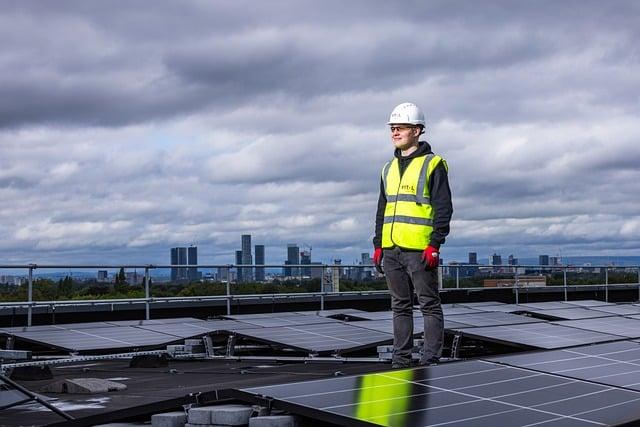In the modern quest for sustainable energy solutions, solar power has emerged as a shining beacon of hope, promising a future where our homes and cities are powered by the sun’s abundant rays. Touted as a green alternative to fossil fuels, solar energy is celebrated for its potential to reduce carbon footprints and mitigate climate change. However, beneath the glistening surface of solar panels lies a complex narrative of manufacturing processes and waste management that prompts a deeper examination. Is solar energy truly as green as it seems, or does the shadow of industrial waste dim its luster? This article delves into the often-overlooked environmental impact of solar panel production, exploring the balance between the promise of clean energy and the realities of manufacturing waste. Join us as we journey beyond the sunlight to uncover the true color of solar energy’s ecological footprint.
Examining the Environmental Footprint of Solar Panel Production
The journey of a solar panel from raw materials to a fully functional energy generator is not without its environmental costs. The production process involves the extraction of raw materials such as quartz, which is then refined into silicon—a key component in most solar panels. This process requires significant energy, often sourced from non-renewable resources, which adds to the carbon footprint of solar panel manufacturing. Furthermore, the chemicals used in the purification and production phases can lead to toxic waste, posing challenges for waste management and environmental safety.
Beyond energy consumption and waste generation, the supply chain associated with solar panel production includes the transportation of materials and components, which further contributes to greenhouse gas emissions. Additionally, the lifecycle of solar panels raises questions about end-of-life disposal. Currently, recycling facilities are limited, and improper disposal could lead to environmental degradation. This highlights the importance of developing more sustainable production methods and efficient recycling processes to ensure that solar energy remains a truly green solution.
- Energy-intensive raw material extraction
- Toxic waste from chemical processing
- Carbon footprint from transportation
- Challenges in recycling and disposal
Navigating the Balance Between Clean Energy and Manufacturing Byproducts
As we shift towards a more sustainable future, the allure of solar energy is undeniable. However, the manufacturing process of solar panels raises questions about its environmental footprint. The production of these panels involves the use of hazardous chemicals, such as cadmium and lead, which can lead to toxic waste if not handled correctly. Moreover, the energy-intensive nature of manufacturing processes contributes to carbon emissions, countering some of the green benefits of solar technology.
To address these challenges, the industry is actively exploring innovative solutions. Some key approaches include:
- Recycling programs aimed at reusing materials from decommissioned panels, thus reducing waste.
- Development of more efficient manufacturing techniques that minimize energy consumption and material use.
- Investment in research to discover alternative, less harmful materials for panel production.
These efforts illustrate the delicate balance between harnessing renewable energy and managing the environmental impact of its production. While solar energy offers significant promise, ongoing innovation and regulation are essential to ensure its green potential is fully realized.

Innovative Approaches to Mitigating Waste in Solar Energy Systems
In the quest to ensure solar energy’s eco-friendliness, it’s crucial to address the often-overlooked issue of manufacturing waste. Innovative approaches are being developed to tackle this problem, focusing on minimizing the environmental impact of solar panel production. Researchers and companies are exploring the use of recycled materials in the manufacturing process, reducing the reliance on virgin resources. Additionally, advancements in thin-film solar technology are helping to decrease the amount of raw materials required, leading to less waste generated per unit of energy produced.
Moreover, the implementation of circular economy principles is gaining traction in the solar industry. This involves designing panels for easy disassembly and recycling, ensuring that materials can be reused at the end of a panel’s lifecycle. Other strategies include:
- Adopting closed-loop recycling systems to recover valuable materials.
- Utilizing biodegradable materials in solar panel components.
- Incorporating waste-to-energy technologies to manage and repurpose production by-products.
By embracing these strategies, the solar industry can significantly reduce its waste footprint, enhancing the sustainability of solar energy as a truly green alternative.

Recommendations for Enhancing Sustainability in Solar Technology Development
To advance sustainability in the solar technology sector, it is crucial to adopt a multifaceted approach that addresses the entire lifecycle of solar products. One effective strategy is to focus on the design and material selection of solar panels. By choosing materials that are not only efficient but also environmentally friendly, manufacturers can significantly reduce the ecological footprint of solar panel production. Moreover, integrating recyclable components into the design can facilitate easier recycling processes, minimizing waste at the end of the product’s life.
Another pivotal recommendation is to enhance manufacturing processes through the adoption of clean and renewable energy sources. This can be achieved by investing in energy-efficient manufacturing technologies and processes that decrease energy consumption and reduce greenhouse gas emissions. Additionally, fostering collaborative partnerships between manufacturers, governments, and research institutions can drive innovation and the development of more sustainable practices. Encouraging policies that support extended producer responsibility can also ensure that companies remain accountable for the environmental impact of their products throughout their lifecycle.
The Conclusion
In the quest for a sustainable future, the brilliance of solar energy shines brightly, yet casts a shadow that demands our attention. As we stand on the precipice of a green revolution, it is crucial to peer beyond the gleaming panels and reflect on the journey they embark upon before capturing the sun’s embrace. The intricate dance between innovation and environmental stewardship compels us to question, to explore, and to innovate further. Solar energy, with all its potential, invites us to reconsider the full spectrum of its impact—from the birth of silicon cells to their eventual retirement. Only by acknowledging and addressing the manufacturing footprints can we truly honor our commitment to a greener planet. As the sun sets on our exploration today, let it rise tomorrow on a world more informed, more responsible, and ever more hopeful.

































